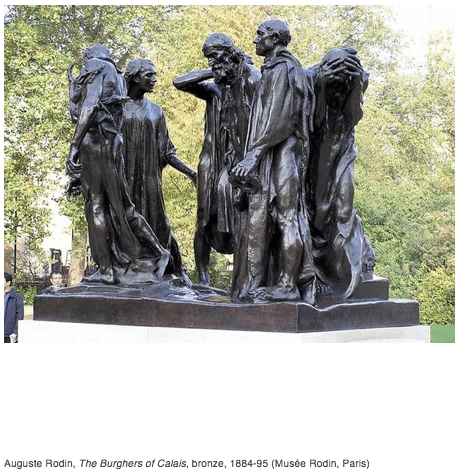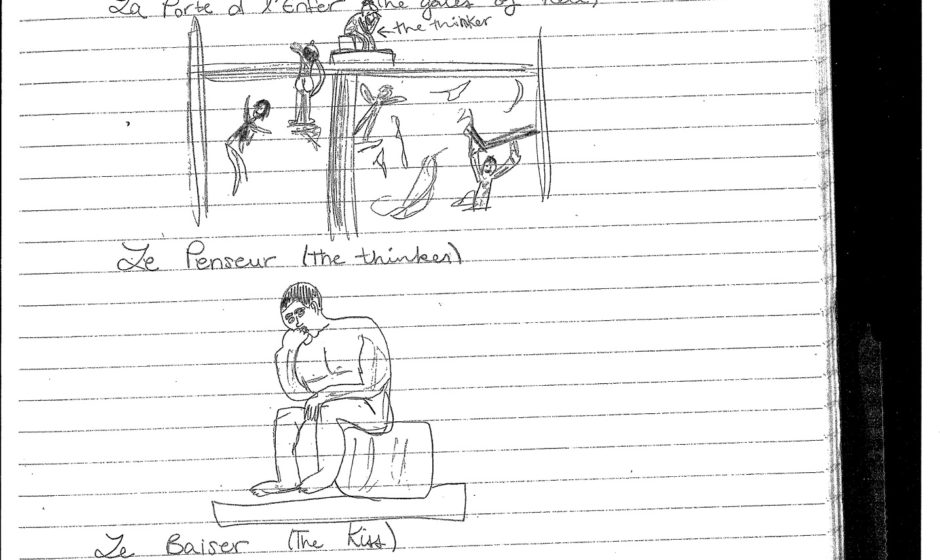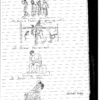“Burghers of Calais” by Auguste Rodin
Developed by Kathleen McCrillis
Miami East High School, Casstown
French
Grade Level: French III or IV (may be adapted to French I or II, history, or Cultural Literacy)
Introduction
History has many lessons for those who listen. For those who pay attention much can be gathered from the music, dance, and visual art of a given period in time. French teacher Kathleen McCrillis, from Miami East High School, uses what she learns at workshops to construct lessons with a depth of understanding not often seen at the high school level. In this case she asks her French I students to examine the work of Auguste Rodin, Burghers of Calais, to examine the distress of some of those involved in The Hundred Years War between France and England. Kathleen uses an activity learned at the Muse Machine’s Advanced Teacher Training Seminar 2016 at the Noguchi Museum in New York City where they were asked to write down what they saw, what they thought, and what they wondered about a particular sculpture before revealing anything about the piece. Kathleen uses this method with her French students as well as observation, tableau, sketching, and group sharing, as vehicles of learning for her students. Please examine this masterful lesson as an example of the best design of instructional strategies gleaned from an educational seminar.


Competencies, Process and Content Statements
Communication Standard
Communicate in languages other than English, both in person and via technology.
Interpretive Communication (Reading, Listening/Viewing)
Competency # 1
- Derive meaning from messages and texts using listening, reading and viewing strategies.
- Make use of print and digital resources to understand the meaning of new words and expressions.
- Utilize knowledge of word families/characters and cognates to figure out the meaning of new words and expressions.
Competency #3
- Comprehend and interpret information in authentic messages and informational texts.
- Follow complex instructions, directions and requests.
Interpersonal Communication (Speaking/Signing, Listening/Viewing, Reading and Writing)
Competency # 3
- Express preferences, feelings, emotions and opinions about familiar and some unfamiliar topics.
- Ask and answer more nuanced questions about feelings, emotions and preferences.
Presentational Communication (Speaking/Signing and Writing)
Competency # 2
- Present information, concepts and viewpoints on familiar and some unfamiliar topics from across disciplines.
- Create and present more extensive lists and classifications.
Competency # 3
- Present literary, creative and artistic endeavors to audiences near or far.
- Recite or retell authentic stories, folktales, poems, rhymes and legends using appropriate gestures.
Cultures Standard: Gain and use knowledge and understanding of other cultures.
Competency # 2
- Experience the target language and culture(s) and share information and personal reactions with others.
- Analyze, explain and create replicas of important objects, images and symbols.
- Use authentic digital and print media.
Enduring Understandings
- The human experience is the same across cultures and time.
- There is a very heavy human cost to war.
Level of Inquiry (confirmation/structured/guided/open) Circle and describe
The activities in this lesson plan reflect a structured inquiry, where the students investigate teacher-presented questions through a prescribed procedure. Even though these are high school level students, they are operating with much lower language skills, in a foreign language.
Essential Questions
- What are the shared human experiences across cultures and time?
- What are the human costs of war?
Content Elaborations
Students will learn …
- New French vocabulary, related to history and art.
- The history of a true event that took place during the Hundred Years War, the Seige of Calais, from 1346-1347, whereby six citizens were willing to sacrifice their lives to save the rest of the inhabitants of their city, which was not uncommon during the Middle Ages.
- The name and style of Auguste Rodin, one of the most important French sculptors of the second half of the nineteenth century, and considered one of the fathers of modern sculpture.
- The title and background of one of his greatest works, Les Bourgeois de Calais (The Burghers of Calais).
Students will practice and strengthen their skills in… listening, speaking, reading, and writing through interpretive, intrapersonal, and presentational communication. The entire class will be conducted in French.
Expectations for Learning
Students will demonstrate this learning by…
- Staying in the target language, French, the entire class period.
- Participating in all of the individual, group, and whole class activities.
- Orally answering teacher questions about the content both today and tomorrow.
Instructional Strategies
- Co-operative learning
- Integration of content areas
- Nonlinguistic representations
Assessment (Pre and/or Post)
The teacher will use formative assessment as he/she walks about the room, looking at student writing, listening to student conversations, and observing their contribution to their group. The teacher will provide immediate feedback to individual students and also write down observations in an anecdotal notebook to adjust instruction based on individual needs.
Materials & Resources
Materials list for Teachers:
- SmartBoard and computer
- 4-5 8 ½ by 11 sheets of cardstock and felt pens for each group of six
- Classroom set of large French/English dictionaries for those students who prefer that reference to an online dictionary, such as wordreference.com
Materials list for Students:
- a smart device for each student( phone, tablet, or laptop)
- notebook and writing utensil
Key Vocabulary
- Le bourgeois– solid citizen of a city
- Calais– city in northern France
- La sculpture– sculpture
- L’oeuvre– work
- La guerre– war
- Le monde– world
- Le coût– cost
- Le tableau vivant– scene of silent and motionless costumed actors depicting a work of art.
Student Performance Tasks
The students will…
- Copy key vocabulary words for the lesson from the SmartBoard and repeat them after the teacher.
- View a large, SmartBoard image of Auguste Rodin’s Les Bourgeois de Calais (The Burghers of Calais), without yet being given the title or artist’s name.
- Jot down words and phrases in a notebook, answering three questions about the sculpture, written on the board and read aloud by the teacher:
- Qu’est-ce que tu vois? (What do you see?)
- Qu’est-ce que tu penses? (What do you think?)
- Qu’est-ce que tu te demandes? (What do you wonder?)
- Get put into groups of 6 to share their answers aloud.
- Choose one member of their group to share a summary of their thoughts with the class.
- Remaining in their groups for the rest of the class, use their smart phones, tablets, or laptops to go to Wikipedia.fr and type in the title of the work, Les Bourgeois de Calais.
- Answer three questions:
- Qui est l’artiste? (Who is the artist?)
- Quand a-t-il créé cet oeuvre? (When did he create this work?)
- Cette scène était pendant quelle guerre dans l’histoire de France?
(This scene was during what war in the history of France?)
- Share their answers with the group, then the class.
- Viewing the French Wikipedia article on the SmartBoard, listen to a brief explanation by the teacher of the situation of the six figures in the sculpture and how their story turned out.
- In their group, research on their smartphones , tablets, or laptops and write down their answers on 8 ½ by 11 sheets of cardstock to the following questions:
- Où sont les guerres dans le monde aujourd’hui? (Where are the wars in the world today?
- Quelles sont les conséquences, ou les coûts humains de la guerre? (What are the consequences, or human costs, of war?
- As a group, in front of the class, share their results aloud and visually on the cards. Turn them in to the teacher to be displayed on a bulletin board.
- Each member pick one of the six figures to sketch in their notebook, so that all of the six figures are covered for each group. Use their devices to find images.
- Each group create a tableau vivant of Les Bourgeois de Calais.
As a group, decide what each person should bring to class tomorrow (ex. bedsheet, rope, etc.) to best create the tableau and be photographed.
Career Connections
• S. Army linguistics
• Foreign Service
• international business and finance
• engineering with international companies
• teaching
• mission work
• travel industry
Diverse Learners
The students will be put into diverse ability groups so that all groups have an opportunity for success with the activities. Peer collaboration will give students the opportunity to contribute their particular gifts and to benefit from others’ gifts. The activities of this lesson incorporate the three learning styles: visual, auditory, and kinesthetic. Analyzing the visual art, reading the French website on their smart devices, and seeing the answers to questions on card stock will appeal to the visual learners. Hearing the directions aloud, discussing their thoughts within their groups, and hearing the teacher explain the history that can be read on the SmartBoard will appeal to the auditory learners. Having the freedom to get out of their seats and take a closer look at the artwork on the SmartBoard, sketching a figure in their notebook, and using their body to create a tableau will appeal to the kinesthetic learners.
The activities have also been planned with multiple intelligences in mind: visual-spatial, verbal-linguistic, bodily-kinesthetic, interpersonal, and intrapersonal.
Interdisciplinary Connections
In my 19 years as a Muse Machine advisor, I have incorporated ideas from ATTS, the Muse Machine Summer Workshops, and other Muse teacher development offered throughout the year in countless ways into my French I, II, III, and IV classes, as well as a Cultural Literacy class I taught for six years. Muse Machine has inspired whole units, as well as creative and engaging activities to incorporate into virtually any unit I teach. It has also validated my own instincts on the very nature of teaching.
In this particular lesson, the first activity came from what I experienced on the ATTS 2016 trip at the Noguchi Museum, founded and designed by Japanese-American artist, Isamu Noguchi. There, my group was shown several large sculptures by Noguchi and asked to write down what we saw, what we thought, and what we wondered. Without being given any background information or critical analysis, we were given the freedom to explore and react to these works in silence, on our own. It was an empowering way to engage in the art. It made the encounter much more personal, so the sharing and discussion afterward was much richer. In this first activity of my lesson, I have tried to give students a similar intimate, reflective space in their first encounter with Rodin’s intensely emotional sculpture.
The sketching activity that comes later in the lesson was inspired by an experience I had on the ATTS 2015 trip at the Metropolitan Museum of Art. After a very helpful workshop on writing essential questions, we were taken into one of the galleries and asked to sketch Emanuel Leutze’s mammoth painting, Washington Crossing the Delaware. Imagine my consternation at being given such a task, when drawing is one of my least natural inclinations! But Muse Machine workshops at their best challenge teachers to get out of their comfort zones and grow in the ways they expect their students to grow and to feel what their students feel in that awkward moment before discovery. I was amazed at how much more I was able to get out of the painting when I had to really pay attention to the detail, by drawing it. This past school year, when I had French II students spend 10 minutes drawing Rodin’s most famous works, I was truly amazed by how each individual captured them. One student, whose work is included here, seemed to effortlessly capture the essence of Rodin’s works, without having taken any art classes in high school.
The final activity, the tableaux vivants, is another idea that I got from a Muse workshop years ago. It’s an idea that has been around for a long time, but it was new to me then, and I have had students create tableaux over the years to portray a vocabulary word or capture a scene from literature. The purpose of the activity in this lesson is to have each student study the stance and facial expression of their “character” so they can imitate it and, hopefully, start to better understand the pain involved with war, Rodin’s ability to express emotion, and the universality of human experience.
Technology Connections
The teacher will use the classroom SmartBoard to display a large photo of the work of art. With this technology, the classroom is more than ever able to be transformed into a “museum.” When students are sharing ideas, they can show the entire class what they saw in the art. The teacher will also use the SmartBoard to experience a French website together with the students, having the students come up and circle where they found answers to questions and highlight main ideas.
The students will use their smartphones, tablets, or laptops to both answer discreet questions and research more open ended questions.
Home/At Work Connections
In my French classroom students usually have daily homework in grammar or literature. For this lesson, the only homework is to bring in items from home for them to wear or hold to create the final tableau to be photographed and put on display, along with the text put on the cardstock that was created about wars and consequences around the world today.

